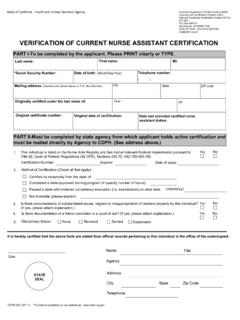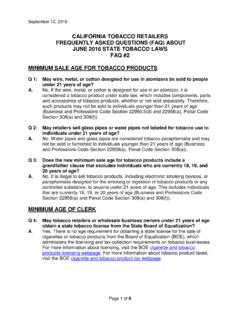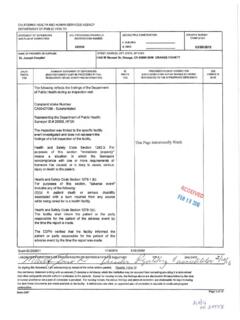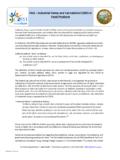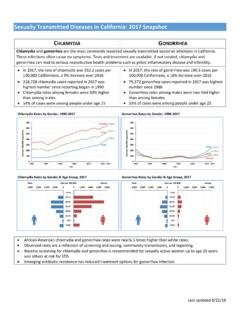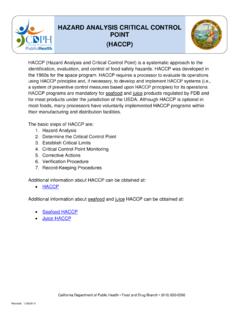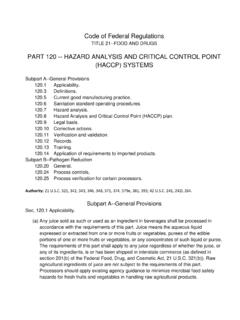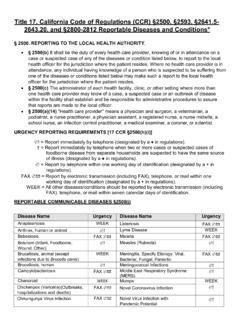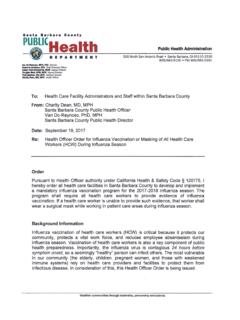Transcription of Cleaning, Disinfection, and Sterilization, and Care of the ...
1 HEALTHCARE-ASSOCIATED INFECTIONS PROGRAMB asics of Infection PreventionHealthcare-Associated Infections ProgramCenter for Health Care QualityCalifornia Department of Public HealthCleaning, Disinfection, and Sterilization, and Care of the EnvironmentLast Updated 2015 HEALTHCARE-ASSOCIATED INFECTIONS PROGRAMO bjectives Describe basic principles of cleaning, disinfection, and sterilization Describe how to monitor cleaning, disinfection, and sterilization processes Describe the relationship between the healthcare environment and infection prevention Identify key systems and practices that contribute to infection prevention Identify practices to reduce the risk of environmentally-related healthcare-associated infections (HAI)2 HEALTHCARE-ASSOCIATED INFECTIONS PROGRAMCLEANING, DISINFECTION, AND STERILIZATIONPart I3 HEALTHCARE-ASSOCIATED INFECTIONS PROGRAMT erminology4 Cleaning: removal of debris ( , dirt, food, blood, saliva).
2 Reduces the amount of organic matter that contributes to proliferation of bacteria and viruses Disinfection: removes most organisms present on surfaces that can cause infection or disease Sterilization: Killing or removal of all organismsHEALTHCARE-ASSOCIATED INFECTIONS PROGRAMC leaning, Disinfection, and Sterilization in Healthcare Settings Practice standards are based on Spaulding s Classification system Healthcare devices and equipment designated as: Critical Semi-critical Non-critical Categories define level of reprocessing required5 HEALTHCARE-ASSOCIATED INFECTIONS PROGRAMC ritical Items Require sterilization Includes items that enter sterile tissue or the vascular system Examples.
3 Surgical instruments and accessories, biopsy forceps, cardiac and urinary catheters, implants, needles6 HEALTHCARE-ASSOCIATED INFECTIONS PROGRAMSemi-Critical Items Require minimum high level disinfectionor sterilization Includes items in contact with non-intact skin or mucous membranes Cleaning process must precede high-level disinfection Examples: respiratory therapy equipment, anesthesia equipment, flexible and larnygoscopes, bronchoscopes, GI endoscopes, cystocopes,vaginal ultrasonic probes7 HEALTHCARE-ASSOCIATED INFECTIONS PROGRAMNon-Critical Items Require intermediate-level or low-level disinfection Includes items in contact only with intact skin Examples.
4 Blood pressure cuffs, stethoscopes, durable mobile patient equipment8 HEALTHCARE-ASSOCIATED INFECTIONS PROGRAME nvironmental Cleaning and Disinfection9 Patient environment can facilitate transmission of bacteria and viruses By direct contact On hands of healthcare personnel Contaminated surfaces increase potential for transmission of bacteria and viruses between patients Items categorized as non-critical need intermediate or low disinfection- or require cleaning onlyHEALTHCARE-ASSOCIATED INFECTIONS PROGRAMP olicy Considerations Include, in policy.
5 Surfaces and equipment that can reasonably be expected to be contaminated by bacteria (high touch surfaces) Define responsibility and frequency for cleaning and disinfecting patient care equipment and surfaces10 HEALTHCARE-ASSOCIATED INFECTIONS PROGRAMP olicy Considerations - 2 Monitor compliance with policy Ensure staff are able to answer: How do you know whether this item has been cleaned and disinfected? Cleaned and disinfected items should be labeled with date and time11 HEALTHCARE-ASSOCIATED INFECTIONS PROGRAM Considered non-critical Must be cleaned thendisinfected on a regular basis Examples.
6 Bedrail Call bell Light switches Doorknobs TV remote IV pump Toilet, commode chair IV poles12 High Touch Surfaces in Patient Rooms Computer keyboard Telephone Over bed table Respiratory and other bedside equipment ChairsHEALTHCARE-ASSOCIATED INFECTIONS PROGRAMI ncreased Acquisition Risk from Prior Infected Room Occupant13 HEALTHCARE-ASSOCIATED INFECTIONS PROGRAMI tems Requiring Cleaning Only Floors, walls, and windows Chairs and other furniture used by individuals who are clothed Private offices and other non-public, non-patient care areas Bed curtains should be changed when soiled and with terminal cleaningClarify in policy what needs to be cleaned and not necessarily disinfected14 HEALTHCARE-ASSOCIATED INFECTIONS PROGRAMUse Microfiber for Cleaning Densely constructed synthetic strands ~1/16ththe diameter of a human hair Attracts dust and cleans ~50% better than comparable cotton Easier to use, lighter, designed for repeat usageHICPAC Disinfection & Sterilization Guideline 2008.
7 Rutala 15 HEALTHCARE-ASSOCIATED INFECTIONS PROGRAMM onitor Environmental Cleaning Processes16 Bioluminescence (outcome measure) Monitors for light emissions produced in organism is present Results are difficult to interpret because it is unknown whether organism remains viable and thus transmissible ExpensiveHEALTHCARE-ASSOCIATED INFECTIONS PROGRAMM onitor Environmental Cleaning Processes - 217 Fluorescence (process measure) Monitors for chemical markers that fluoresce with ultraviolet light if not removed during cleaning Culturing Use only during some outbreak investigations Visual inspection Make routine rounds and provide feedback to frontline staffHEALTHCARE-ASSOCIATED INFECTIONS PROGRAML inens18 All linen handled as if contaminated with blood or body fluids (standard precautions)
8 Bag linen at point of use Wear PPE when sorting and agitate minimally Laundry equipment must be maintained to prevent microbial contamination (manufacturer s instructions for use must be followed)HEALTHCARE-ASSOCIATED INFECTIONS PROGRAML inens - 219 New laundry technologies allow linen washing without requirements for hot water and chlorines Hot water: 160 F x 25 minutes Cold water: 71-77 F with 125ppm chlorine bleach rinse or equivalent detergent Detergents not required to have stated antimicrobial claims Manufactures instructions for use must be followedHEALTHCARE-ASSOCIATED INFECTIONS PROGRAMC leaning, Disinfection, and Sterilization of Medical instruments and Devices Disinfection or sterilization cannot be achieved without cleaning first Organic material dilutes disinfectants Bioburden must be reduced for processes to be effective Cleanall medical instruments and devices by.
9 Removing visible soil Disconnecting or separating instrument parts Avoiding organic material drying on equipment by rinsing or soaking in an enzymatic solution20 HEALTHCARE-ASSOCIATED INFECTIONS PROGRAMP ersonal ProtectionWhen cleaning soiled medical instruments , wear: Long-sleeved impervious gowns Eyewear Mask or mask with face shield Gloves Cap Chemical goggles (when mixing or changing solution)21 HEALTHCARE-ASSOCIATED INFECTIONS PROGRAMD isinfection Eliminates or kills most bacteria, many virus types, some fungi (not prions) Cannot be accomplished without first cleaning Time-dependent process Levels of disinfection.
10 High, intermediate, or low Hospitals must use EPA-approved product for desired levels of disinfection Product must have a tuberculocidal label claim at minimum22 HEALTHCARE-ASSOCIATED INFECTIONS PROGRAMD isinfection - 2 Follow manufacturer s recommendations to achieve disinfection and to avoid medical device damage Use correct dilution; more is notbetter Use correct contact time Use correct temperature23 HEALTHCARE-ASSOCIATED INFECTIONS PROGRAMD isinfection - 3 Understand employee and environmental safety issues Do not exceed exposure limits Know permissible exposure levels Assess compatibility with gloves, basins, other products24 HEALTHCARE-ASSOCIATED INFECTIONS PROGRAMEPA Registration of Disinfectants25 Labeled as high, intermediate, or low level May include degrees of approval Limited approval ( , kills Hepatitis B and HIV.)

